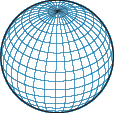Using the Latitude Longitude Coordinate System
The latitude longitude coordinate system uses angular measurements to describe a position on the surface of the earth. The system has been in use, with little change, since the astronomer Ptolemy used them in his first world atlas in A.D. 150.
Mariners and aviators have been the primary users of latitude/longitude in the past. The system is used on a worldwide basis and many different types of maps have lat/lon markings.
Recently, the availability of inexpensive Global Positioning System receivers has made position information available to many more people than ever before. With that comes the need to understand how coordinate systems work, and how to relate them to points on a map.
Most GPS receivers are set to use lat/lon coordinates as their default factory setting. Thus, most new GPS users start out using lat/lon coordinates.
There are other geographic coordinate systems in common use. You may find that they are well suited to your needs and easier to use than lat/lon. Refer to the page on Selecting a Geographic Coordinate System for a comparison of different systems.
The following pages should provide you with the details you need to successfully work with the lat/lon coordinate system.
Latitude and Longitude Defined
Formats and Symbols
Plotting and Measuring Lat/Lon
Video Tutorial on Plotting and Measuring Lat/Lon
An Exercise to Test Your Knowledge
Answers to the Exercise
MapTools Lat/Lon Rulers
